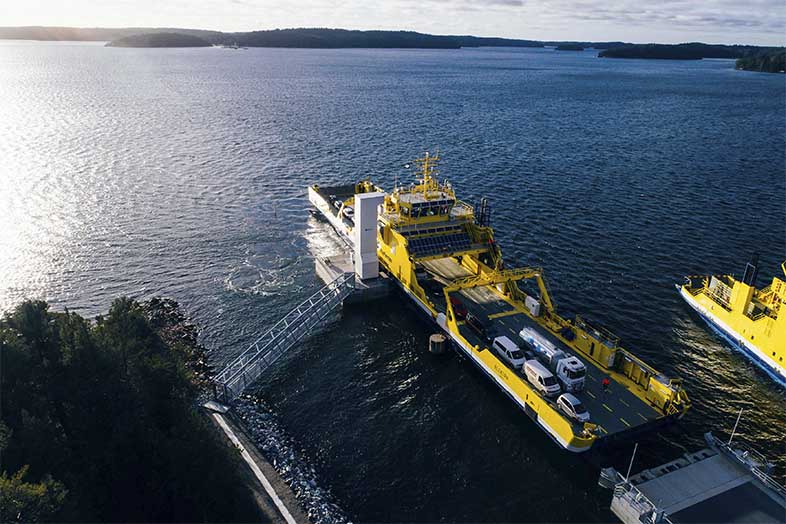
Excerpts from Stevie Knights articles published in Maritime Journal. Links to original article here.
New tech comes with a price, but there’s a lot resting on it – all the more so when it concerns a commercial, battery-driven ro-ro that promises to clean up the market in more ways than one.
The power for Finland’s new battery ro-ro, Elektra is the 1MW PBES energy storage system, split into two banks, powering a pair of 900kW, Z-drive, azimuthing thrusters from Rolls-Royce: “These mean Elektra can actually move sideways, so it’s easy to manoeuvre,” said Mats Rosin, FinFerries’ CEO. The 97.92m Elektra needs to be a 24/7 workhorse as it’s expected to run four times an hour during peak hours and once an hour overnight. The 1.6km ‘gateway’ between Parainen and Nauvo has between 600,000 and 800,000 vehicles crossing a year including heavy goods trucks but a sharp summer spike means over 100,000 vehicles in July alone.
There are recharging points at both the Parainen and Nauvo turnarounds; a Cavotec vacuum mooring system and recharging tower combo holds Elektra in place while allowing a plug to descend from above to mate with Elektra. The 20kV of power is delivered to a transformer some 150m from the charging tower which reduces it to 690V AC for transfer to the ship. The grid had been recently strengthened nearby, and so it was able to deliver the necessary charge.
The 160 6.5kWh PBES Power batteries have been lined up for an installed total of 1,040kWh at 1,000V on the DC bus. Elektra uses roughly 125kWh from shore every 30 minutes. However, the batteries could absorb power at quite a rate as the banks can comfortably charge at 3C, so they could, theoretically, fully charge from empty in 20 minutes. This is partly because the batteries are liquid cooled; after all, putting a bolt of energy through even capacious batteries can shorten the cell’s lifetime.
It’s not seawater from outside but rather a closed loop of tightly temperature-controlled tap water (the region’s domestic supply being incredibly pure and uncontaminated).
More, as depth of discharge also affects the cells’ lifetime, these too are being rigorously bracketed, with the top rising to no more than 80% and the bottom sinking no lower than 60% of the total capacity. Of course, Siemens’ will be watching, monitoring all this and more via a Cloud link.
It’s nice that while Siemens ties battery information together on the touchscreens mounted in both the bridge and power control room, PBES has also installed easy-to-read data displays on each case, showing heat, loading rate, state of charge, state of health and so on, not just for that battery alone but for the whole bank.
The new ro-ro also is fairly comfortable to operate, just as well since the shifts are 12 hours long, with just a captain, engineer and deckhand onboard. It’s quiet: even in the so-called ‘engine room’, there’s normally no need to raise your voice, the only residual vibration comes from the 900kW Rolls-Royce Z-drive thrusters although there are three auxiliary gensets for redundant power for charging failures or ice conditions.
Despite the investment, pegged at around 20mEuro for the total project including infrastructure, Elektra’s very cheap to run – based on Ampere’s figures it probably costs no more than a handful of Euros for each recharge. The most important thing about ‘Elektra’, Finland’s new, double-ended ferry is that it paves the way for a new breed of vessel.